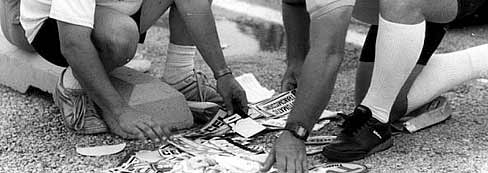|
Drag racing's contingency programs need help
By Jeff Burk
5/18/05

DRO file photo
 he
recent flap over a sanctioning body's decision to penalize
a racer who was "slapping decals" between rounds
by taking all of that racer's money away has demonstrated
that one of drag racing's sacred cows, the contingency program
that rewards winning racers for buying and using certain
products with cash payments, may be in serious trouble. And
the trouble is being caused by racers and manufacturers who
abuse a program that is becoming increasingly less cost-effective
for all concerned. he
recent flap over a sanctioning body's decision to penalize
a racer who was "slapping decals" between rounds
by taking all of that racer's money away has demonstrated
that one of drag racing's sacred cows, the contingency program
that rewards winning racers for buying and using certain
products with cash payments, may be in serious trouble. And
the trouble is being caused by racers and manufacturers who
abuse a program that is becoming increasingly less cost-effective
for all concerned.
Basically, a contingency program for any racing series is
nothing more than an advertising contract between a racer
and the company that makes products used by the racers. The
premise of a contingency program is really simple. The companies
generally pay the Sportsman racers if they make the final
round, use the manufacturer's product, and have the decal
somewhere on the car.
For more than four decades the contingency programs in racing
series have been a fabulous success. So many companies joined
the program that major series such as the NHRA and the IHRA
are able to get by without guaranteeing very much prize money
in the Sportsman ranks. Because of the large number of companies
involved, a racer could potentially win 10 or 15 times as
much money as the sanctioning body puts up. A Sportsman racer
might get $1000-$1500 to win from the sanctioning body, but
if he collected all of the contingency money posted by the
manufacturers he could take home $15,000 or more at the end
of the day.
The contingency programs made everyone happy. The racers
who were lucky or good enough to get to the final round could
count on a reasonable payday in addition to their "Wally" or "Iron
Man," and the sanctioning body and track owners didn't
have to put up a lot
ADVERTISEMENT
 |
of their own money for purses. The racers
were getting more money, the sanctioning body
made more (or
in some cases made a little) money and the manufacturers
got the benefits of the racers advertising their product.
But, as the saying goes, all good things must come to an
end and apparently that is what may be happening to contingency
programs in drag racing. What has happened is a combination
of the program becoming too successful, some racers being
just too greedy, and some manufacturers not following through.
When the contingency programs began in drag racing it was
basically on the honor system. If a racer got to the final
round, the manufacturer paid the racer if he or she had the
decal on the car. In many cases it was impossible to know
for sure if the racer indeed had the part they said they
had on the car or in the engine so the companies went on
the honor system and rather than tear down every car, they
just paid.
As the programs were enlarged to include divisional races
and class wins, as well as National events, the amount of
money paid out by companies such as Comp Cams, Moroso, Strange,
Holley, Edelbrock and MSD, just to name a few, became a very
significant amount of money -- above six figures! The companies
had to have a full-time staff to administrate the programs.
On top of that, the sanctioning bodies levied a fee on the
manufacturers just to participate that was above and beyond
what the manufacturers paid the racers.
When the money being paid out to the racers got to be more
than anyone had ever anticipated, the manufacturers either
hired their own people or demanded that the sanctioning bodies
supply someone to verify that a racer who got to the final
round indeed had the parts on their car or in their engine
that matched the stickers they had on the car. They did this
because it had become very evident that some racers were
(and still are) putting product decals on their cars for
products they don't use and then claiming contingency payouts.
The core of the problem for many manufacturers is that too
often there is no one who can verify if a racer actually
is using the products he claims. And in the case of those
components that can't be easily identified or are in the
engine, there simply is no way to verify short of tearing
the winner and runner-up cars apart after each win. No one
has the manpower or time to do that when there are anywhere
from 10-13 classes of competition at major events.

|
